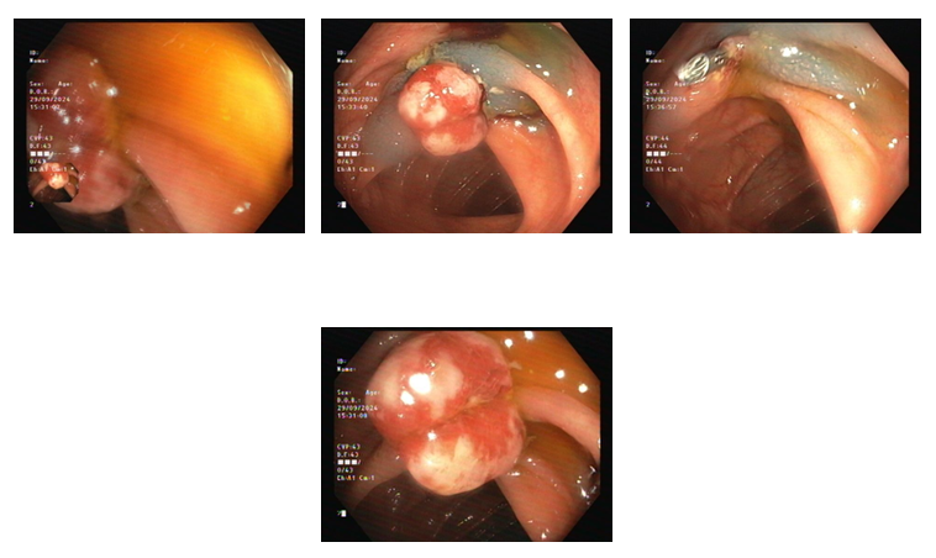Tuesday Poster Session
Category: Colon
P4726 - Unexpected Cytomegalovirus Inclusions in Inflammatory Colonic Polyp in a Non-Immunocompromised Patient: A Case Report
Tuesday, October 28, 2025
10:30 AM - 4:00 PM PDT
Location: Exhibit Hall

Bader Aldahash (he/him/his)
King Faisal Specialist Hospital and Research Centre
Riyadh, Ar Riyad, Saudi Arabia
Presenting Author(s)
Bader Aldahash, , Bader Alajlan,
King Faisal Specialist Hospital and Research Centre, Riyadh, Ar Riyad, Saudi Arabia
Introduction: CMV is a double-stranded DNA herpes virus infecting 50–80% of US adults by age 40. Most infections are mild or asymptomatic. In immunocompromised patients, it can cause disseminated or localized end-organ disease. While 80–90% of transplant recipients are infected, only 30–40% develop active illness. Diagnosis involves colonoscopy with biopsy (polyps or pseudotumors). This case reports rare inflammatory and adenomatous polyps in a patient with CMV inclusions in an ascending colon polyp. CMV in immunocompetent colon tissue is unusual and may indicate underlying inflammation increasing susceptibility to infection.
Case Description/
Methods: A 73-year-old man with HTN, BPH, and IHD was transferred for screening colonoscopy. Labs showed WBC 6.7, neutrophil count 4.24, hemoglobin 14, platelets 228, CRP 1.3, Cr 76, and fecal calprotectin 176. He denied diarrhea, bleeding, or abdominal pain, with no family history of cancer and no weight changes. Colonoscopy revealed a 1.6 cm semi-pedunculated polyp in the proximal ascending colon, which was removed with en bloc resection (Figure 1). A 4 mm sessile polyp in the distal sigmoid was also excised. The rest of the colon appeared normal. Biopsy results are shown in (Figure 2).
Discussion: This case involves a non-immunocompromised patient with CMV inclusions in a colonic polyp, showing about seven infected cells with viral cytopathic changes. A low-grade tubular adenoma was also found in the sigmoid colon, indicating potential neoplastic risk. CMV in the GI tract is rare in healthy hosts, but colitis can occur in older patients or those with chronic conditions like diabetes, CAD, or renal disease, especially after ICU stays. Endoscopy reveals three typical CMV colitis patterns: pseudomembranous, diffuse ulcers, and ulcerative types, sometimes with polyps or pseudotumors mimicking cancer. Irregular ulceration has 100% specificity for CMV, and wide mucosal defects 95%. Pseudo tumors are rare but can resemble malignancy, potentially leading to unnecessary colectomy. However, CMV in polyps does not support a direct role in cancer development, and studies have not found CMV DNA or proteins in colorectal cancers. CMV can also cause postoperative complications after colectomy or coexist with lymphoma. In asymptomatic, immunocompetent patients, incidental CMV findings typically don’t require treatment or follow-up, as infection is usually self-limited and asymptomatic without diarrhea, pain, or bleeding.

Figure: semi-pedunculated polyp in the proximal ascending colon

Figure: large cells with inclusions show positive nuclear staining
Disclosures:
Bader Aldahash indicated no relevant financial relationships.
Bader Alajlan indicated no relevant financial relationships.
Bader Aldahash, , Bader Alajlan, . P4726 - Unexpected Cytomegalovirus Inclusions in Inflammatory Colonic Polyp in a Non-Immunocompromised Patient: A Case Report, ACG 2025 Annual Scientific Meeting Abstracts. Phoenix, AZ: American College of Gastroenterology.
King Faisal Specialist Hospital and Research Centre, Riyadh, Ar Riyad, Saudi Arabia
Introduction: CMV is a double-stranded DNA herpes virus infecting 50–80% of US adults by age 40. Most infections are mild or asymptomatic. In immunocompromised patients, it can cause disseminated or localized end-organ disease. While 80–90% of transplant recipients are infected, only 30–40% develop active illness. Diagnosis involves colonoscopy with biopsy (polyps or pseudotumors). This case reports rare inflammatory and adenomatous polyps in a patient with CMV inclusions in an ascending colon polyp. CMV in immunocompetent colon tissue is unusual and may indicate underlying inflammation increasing susceptibility to infection.
Case Description/
Methods: A 73-year-old man with HTN, BPH, and IHD was transferred for screening colonoscopy. Labs showed WBC 6.7, neutrophil count 4.24, hemoglobin 14, platelets 228, CRP 1.3, Cr 76, and fecal calprotectin 176. He denied diarrhea, bleeding, or abdominal pain, with no family history of cancer and no weight changes. Colonoscopy revealed a 1.6 cm semi-pedunculated polyp in the proximal ascending colon, which was removed with en bloc resection (Figure 1). A 4 mm sessile polyp in the distal sigmoid was also excised. The rest of the colon appeared normal. Biopsy results are shown in (Figure 2).
Discussion: This case involves a non-immunocompromised patient with CMV inclusions in a colonic polyp, showing about seven infected cells with viral cytopathic changes. A low-grade tubular adenoma was also found in the sigmoid colon, indicating potential neoplastic risk. CMV in the GI tract is rare in healthy hosts, but colitis can occur in older patients or those with chronic conditions like diabetes, CAD, or renal disease, especially after ICU stays. Endoscopy reveals three typical CMV colitis patterns: pseudomembranous, diffuse ulcers, and ulcerative types, sometimes with polyps or pseudotumors mimicking cancer. Irregular ulceration has 100% specificity for CMV, and wide mucosal defects 95%. Pseudo tumors are rare but can resemble malignancy, potentially leading to unnecessary colectomy. However, CMV in polyps does not support a direct role in cancer development, and studies have not found CMV DNA or proteins in colorectal cancers. CMV can also cause postoperative complications after colectomy or coexist with lymphoma. In asymptomatic, immunocompetent patients, incidental CMV findings typically don’t require treatment or follow-up, as infection is usually self-limited and asymptomatic without diarrhea, pain, or bleeding.

Figure: semi-pedunculated polyp in the proximal ascending colon

Figure: large cells with inclusions show positive nuclear staining
Disclosures:
Bader Aldahash indicated no relevant financial relationships.
Bader Alajlan indicated no relevant financial relationships.
Bader Aldahash, , Bader Alajlan, . P4726 - Unexpected Cytomegalovirus Inclusions in Inflammatory Colonic Polyp in a Non-Immunocompromised Patient: A Case Report, ACG 2025 Annual Scientific Meeting Abstracts. Phoenix, AZ: American College of Gastroenterology.

